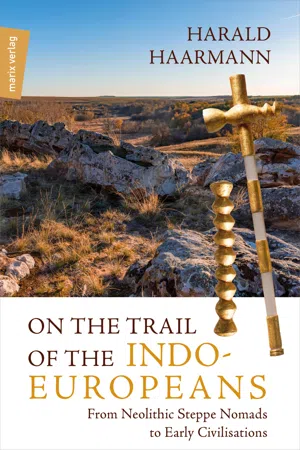
On the Trail of the Indo-Europeans: From Neolithic Steppe Nomads to Early Civilisations
- 368 pages
- English
- ePUB (mobile friendly)
- Available on iOS & Android
On the Trail of the Indo-Europeans: From Neolithic Steppe Nomads to Early Civilisations
About this book
For more than 3000 years, Indo-European languages have been spoken from India through Persia and into Europe. Where are the origins of this language family? How and when did its different linguistic branches emerge? The renowned historical linguist Harald Haarmann provides a graphic account of what we know today about the origins of Indo-European languages and cultures and how they came to be so widely disseminated. In this impressive study, he succeeds in drawing connections between linguistic findings, archaeological discoveries and the latest research into human genetics and climate history. In addition to linguistic affinities, he shows the economic, social and religious concepts that the early speakers of Indo-European languages had in common all the way from the Eastern Mediterranean to the Indus. Particular attention is devoted to the processes of assimilation with pre-Indo-European languages and civilisations. The result is a fascinating panorama of early "Indo-European globalisation" from the end of the last ice age to the early civilisations in Greece, Italy, Asia Minor, Persia and India.
Frequently asked questions
- Essential is ideal for learners and professionals who enjoy exploring a wide range of subjects. Access the Essential Library with 800,000+ trusted titles and best-sellers across business, personal growth, and the humanities. Includes unlimited reading time and Standard Read Aloud voice.
- Complete: Perfect for advanced learners and researchers needing full, unrestricted access. Unlock 1.4M+ books across hundreds of subjects, including academic and specialized titles. The Complete Plan also includes advanced features like Premium Read Aloud and Research Assistant.
Please note we cannot support devices running on iOS 13 and Android 7 or earlier. Learn more about using the app.
Information
Table of contents
- Cover
- Title
- CONTENTS
- Introduction: The mystery of the Indo-Europeans
- 1. Homeland in the southern Russian steppe (11th – 8th millennium BCE)
- 2. Proto-Indo-European language and culture (from the 7th millennium BCE)
- 3. Early steppe nomads: Social systems and worldviews (from the 7th millennium BCE)
- 4. Contacts with farmers to the west (from the 5th millennium BCE)
- 5. The first migration of the steppe nomads (from the middle of the 5th millennium BCE)
- 6. The fragmentation of Proto-Indo-European (from 4000 BCE)
- 7. Southeast Europe: The emergence of Hellenic culture (from the 3rd millennium BCE)
- 8. Apennine Peninsula: The dominance of Latin (from the 2nd millennium BCE)
- 9. The Balkans: Between Roman and Greek Civilisation (from the 2nd millennium BCE)
- 10. Central and Western Europe: Celtic and Germanic peoples (from the 2nd millennium BCE)
- 11. Eastern Europe: Slavs and Balts (from the 2nd millennium BCE)
- 12. Asia Minor: Anatolian languages and cultures (from the 2nd millennium BCE)
- 13. From Central Asia to the Iranian Plateau (from the 2nd millennium BCE)
- 14. India: Dravidians and Aryans (2nd millennium BCE)
- 15. Outlying Indo-European settlements in western China (2nd millennium BCE)
- 16. Experiments with writing: From Linear B to Ogham (1700 BCE – 500 CE)
- 17. Epilogue: Indo-European globalisation
- Bibliography
- Sources of maps and illustrations
- Index
- Copyright
- About the author